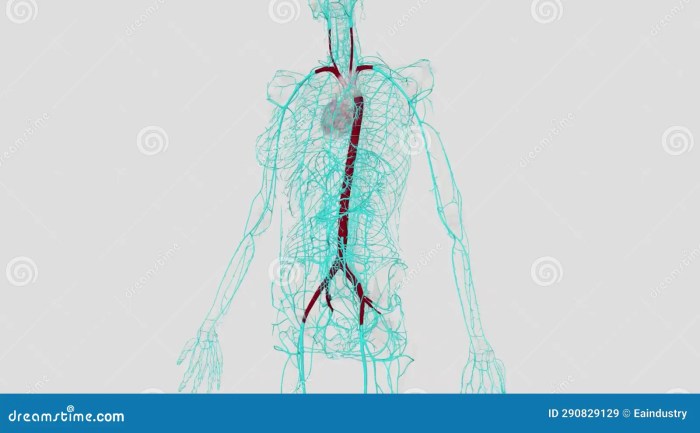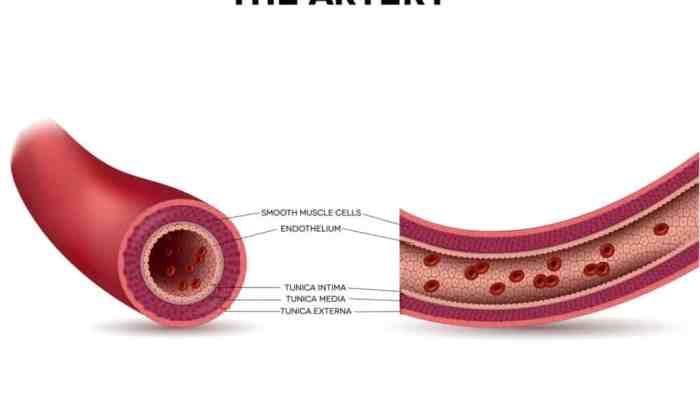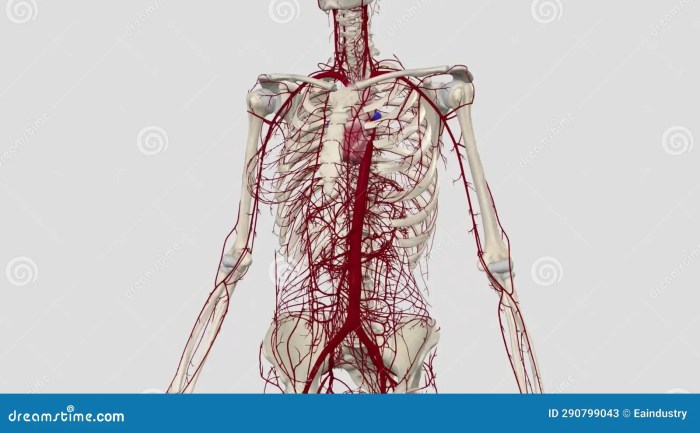Largest artery of the body nyt – Embark on an enlightening journey into the realm of the largest artery of the body, the aorta. This remarkable vessel, stretching from the heart to the abdomen, plays a pivotal role in maintaining our cardiovascular health. Join us as we unravel its anatomy, physiology, and clinical significance, unraveling the mysteries of this vital lifeline.
Prepare to be captivated by the intricate structure of the aorta, its layers, and branches that distribute life-sustaining blood throughout our bodies. Delve into the mechanisms that regulate blood pressure and flow, ensuring the proper functioning of our organs and tissues.
Introduction
The aorta, the largest artery in the human body, plays a crucial role in the circulatory system. It originates from the left ventricle of the heart and branches out to supply oxygenated blood to various organs and tissues throughout the body.
Understanding the anatomy and function of the aorta is essential for comprehending the overall health and well-being of the cardiovascular system.
Anatomy of the Aorta
The aorta is a large, muscular artery that extends from the heart to the abdomen. It is divided into several sections based on its location:
- Ascending aorta:This section originates from the left ventricle and curves upward towards the aortic arch.
- Aortic arch:This section curves over the heart and gives off branches to the head, neck, and upper limbs.
- Descending aorta:This section extends from the aortic arch to the abdomen, where it further divides into the abdominal aorta and the common iliac arteries.
Function of the Aorta
The primary function of the aorta is to transport oxygenated blood away from the heart and distribute it to the body. The aorta branches out into smaller arteries that reach every organ and tissue, delivering essential nutrients and oxygen for cellular function.
Additionally, the aorta plays a role in regulating blood pressure and maintaining overall cardiovascular health.
Structure and Anatomy

The aorta is the largest artery in the human body. It is a thick-walled, elastic blood vessel that originates from the left ventricle of the heart and extends down through the chest and abdomen. The aorta is responsible for carrying oxygenated blood away from the heart and distributing it to the rest of the body.The
aorta is divided into three main sections: the ascending aorta, the aortic arch, and the descending aorta. The ascending aorta begins at the left ventricle and extends up towards the head. The aortic arch curves over the top of the heart and gives off branches to the head, neck, and arms.
The descending aorta continues down through the chest and abdomen, giving off branches to the organs and tissues in these regions.The aortic wall is composed of three layers: the tunica intima, the tunica media, and the tunica adventitia. The tunica intima is the innermost layer and is lined with endothelial cells.
The tunica media is the middle layer and is composed of smooth muscle cells. The tunica adventitia is the outermost layer and is composed of connective tissue.The aorta gives off a number of branches that supply blood to different parts of the body.
The main branches of the aorta include the coronary arteries, the brachiocephalic trunk, the left common carotid artery, the left subclavian artery, the abdominal aorta, and the iliac arteries.The coronary arteries supply blood to the heart muscle. The brachiocephalic trunk gives off branches to the head, neck, and right arm.
The left common carotid artery supplies blood to the left side of the head and neck. The left subclavian artery supplies blood to the left arm. The abdominal aorta gives off branches to the organs and tissues in the abdomen and pelvis.
The iliac arteries supply blood to the legs.
Physiology

The aorta, as the largest artery, plays a crucial role in maintaining blood pressure and blood flow throughout the body. It acts as a central conduit, distributing oxygenated blood from the heart to various organs and tissues.
The aortic valve, located at the base of the aorta, is responsible for ensuring unidirectional blood flow from the left ventricle into the aorta. During systole (heart contraction), the aortic valve opens, allowing blood to be ejected into the aorta.
During diastole (heart relaxation), the aortic valve closes, preventing backflow of blood into the left ventricle.
Regulation of Blood Flow through the Aorta, Largest artery of the body nyt
The regulation of blood flow through the aorta is essential for maintaining adequate tissue perfusion and overall cardiovascular health. Several mechanisms contribute to this regulation:
- Heart Rate and Contractility:The heart rate and the force of myocardial contraction directly influence the volume of blood ejected into the aorta during each cardiac cycle.
- Peripheral Resistance:The resistance offered by the peripheral blood vessels (arterioles and capillaries) affects the flow of blood through the aorta. Increased peripheral resistance leads to decreased blood flow, while decreased peripheral resistance results in increased blood flow.
- Neurohumoral Factors:The autonomic nervous system and various hormones, such as adrenaline and noradrenaline, can influence the diameter of blood vessels, thereby regulating blood flow through the aorta.
Clinical Significance

The aorta is susceptible to various diseases that can significantly impact cardiovascular health. Understanding the clinical significance of aortic disorders is crucial for prompt diagnosis and effective management.
Common Aortic Diseases
- Aortic Aneurysm:An abnormal dilation of the aortic wall, weakening it and increasing the risk of rupture.
- Aortic Dissection:A tear in the inner layer of the aortic wall, allowing blood to leak between the layers and potentially leading to catastrophic outcomes.
- Aortic Stenosis:A narrowing of the aortic valve opening, obstructing blood flow from the heart to the body.
- Coarctation of the Aorta:A congenital narrowing of a segment of the aorta, impeding blood flow to the lower body.
Causes of Aortic Diseases
- Atherosclerosis:Plaque buildup in the aortic wall, leading to weakening and aneurysm formation.
- Genetic Disorders:Certain genetic conditions, such as Marfan syndrome, increase the risk of aortic dilation and dissection.
- Trauma:Blunt or penetrating injuries can damage the aortic wall, predisposing to aneurysms or dissections.
- Infection:Bacterial or fungal infections can weaken the aortic wall, leading to aneurysms or dissections.
Symptoms and Diagnosis
Symptoms of aortic disorders vary depending on the type and severity of the condition. However, common signs include:
- Chest pain
- Shortness of breath
- Fatigue
- Cough
- Hoarseness
Diagnosis involves a thorough medical history, physical examination, and imaging tests, such as echocardiography, CT angiography, or MRI.
Treatment Options
Treatment for aortic diseases depends on the type, severity, and location of the disorder. Options include:
- Surgical Interventions:Open surgery or endovascular repair techniques to repair or replace the affected aortic segment.
- Non-Surgical Interventions:Medications to manage blood pressure, heart rate, and cholesterol levels; lifestyle modifications to reduce risk factors.
Comparative Anatomy

The aorta, the largest artery in the human body, exhibits remarkable variations among different mammalian species, reflecting adaptations to diverse lifestyles and environments. Understanding these variations provides valuable insights into cardiovascular evolution and health.
In the human body, the aorta is the largest artery, carrying oxygenated blood from the heart to the rest of the body. There are also plenty of words that end in the suffix “-ible”, such as words with the suffix ible . This suffix indicates that something is capable of being done or achieved.
The aorta, for example, is responsible for distributing oxygenated blood throughout the body, making it an essential part of the circulatory system.
Structural Adaptations
In general, the aorta of mammals follows a similar basic pattern, originating from the left ventricle of the heart and distributing oxygenated blood to the body. However, the size, shape, and branching patterns of the aorta vary significantly. For example, herbivores like cows and elephants possess a large, muscular aorta to accommodate the high blood flow required for digesting plant material.
Carnivores, such as lions and tigers, have a more slender aorta optimized for speed and agility.
Evolutionary Adaptations
The evolution of the aorta is closely tied to changes in body size, metabolic demands, and locomotor patterns. In larger mammals, such as whales and elephants, the aorta is proportionally larger and thicker to maintain adequate blood pressure and oxygen delivery.
In contrast, smaller mammals, such as mice and bats, have a relatively smaller aorta to minimize energy expenditure.
Clinical Significance
Variations in aortic structure can have implications for cardiovascular health. For instance, certain breeds of dogs, such as Great Danes, are prone to aortic rupture due to a weakened aortic wall. Conversely, some species, like giraffes, have evolved a unique aortic arch that allows them to maintain blood pressure despite their extreme height.By
studying comparative anatomy of the aorta, scientists gain insights into the evolutionary adaptations that shape cardiovascular systems and provide a framework for understanding the diverse range of cardiovascular health issues observed in different species.
Research and Future Directions
Ongoing research on the aorta and its diseases aims to improve our understanding of aortic structure, function, and disease mechanisms. This research encompasses a wide range of topics, including:
- Aortic Imaging:Developing advanced imaging techniques to visualize the aorta in detail, detect early signs of disease, and monitor treatment outcomes.
- Aortic Biomechanics:Studying the mechanical properties of the aorta to understand how it withstands blood pressure and how changes in its structure affect its function.
- Aortic Aneurysm Formation and Rupture:Investigating the molecular and cellular mechanisms underlying the development and rupture of aortic aneurysms.
- Aortic Dissection:Understanding the causes and consequences of aortic dissection, a life-threatening condition involving a tear in the aortic wall.
- Aortic Valve Disease:Exploring new therapies for aortic valve disorders, such as aortic stenosis and aortic regurgitation.
Future Research Directions
Future research directions in aortic health include:
- Personalized Medicine:Developing personalized treatment strategies based on an individual’s genetic and environmental risk factors.
- Stem Cell Therapy:Exploring the potential of stem cells to repair damaged aortic tissue and regenerate healthy aortic cells.
- Gene Editing:Investigating the use of gene editing technologies to correct genetic defects that contribute to aortic diseases.
- Novel Drug Therapies:Developing new drugs to prevent and treat aortic diseases by targeting specific molecular pathways.
- Advanced Surgical Techniques:Refining surgical techniques for aortic repair and replacement, including minimally invasive approaches.
Potential Impact of New Technologies and Therapies
Advances in research and technology are expected to have a significant impact on aortic health. New imaging techniques will enable earlier detection and more accurate diagnosis of aortic diseases. Novel drug therapies and surgical techniques will improve treatment outcomes and reduce the risk of complications.
Personalized medicine will allow for tailored treatments that are more effective and have fewer side effects. Overall, these advancements promise to improve the quality of life for individuals with aortic diseases and reduce the burden of these conditions on society.
Popular Questions: Largest Artery Of The Body Nyt
What is the aorta?
The aorta is the largest artery in the human body, responsible for carrying oxygenated blood from the heart to the rest of the body.
What are the main branches of the aorta?
The main branches of the aorta include the brachiocephalic trunk, left common carotid artery, left subclavian artery, thoracic aorta, abdominal aorta, and common iliac arteries.
What is aortic dissection?
Aortic dissection is a life-threatening condition in which the inner layer of the aorta tears, allowing blood to leak between the layers of the aortic wall.